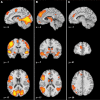The power of emotional valence-from cognitive to affective processes in reading
- PMID: 22754519
- PMCID: PMC3385211
- DOI: 10.3389/fnhum.2012.00192
The power of emotional valence-from cognitive to affective processes in reading
Abstract
The comprehension of stories requires the reader to imagine the cognitive and affective states of the characters. The content of many stories is unpleasant, as they often deal with conflict, disturbance or crisis. Nevertheless, unpleasant stories can be liked and enjoyed. In this fMRI study, we used a parametric approach to examine (1) the capacity of increasing negative valence of story contents to activate the mentalizing network (cognitive and affective theory of mind, ToM), and (2) the neural substrate of liking negatively valenced narratives. A set of 80 short narratives was compiled, ranging from neutral to negative emotional valence. For each story mean rating values on valence and liking were obtained from a group of 32 participants in a prestudy, and later included as parametric regressors in the fMRI analysis. Another group of 24 participants passively read the narratives in a three Tesla MRI scanner. Results revealed a stronger engagement of affective ToM-related brain areas with increasingly negative story valence. Stories that were unpleasant, but simultaneously liked, engaged the medial prefrontal cortex (mPFC), which might reflect the moral exploration of the story content. Further analysis showed that the more the mPFC becomes engaged during the reading of negatively valenced stories, the more coactivation can be observed in other brain areas related to the neural processing of affective ToM and empathy.
Keywords: emotion; empathy; fMRI; liking; literature; reading; theory of mind.
Figures




Similar articles
-
The ventromedial prefrontal cortex is involved in understanding affective but not cognitive theory of mind stories.Soc Neurosci. 2006;1(3-4):149-66. doi: 10.1080/17470910600985589. Soc Neurosci. 2006. PMID: 18633784
-
Functional relations of empathy and mentalizing: an fMRI study on the neural basis of cognitive empathy.Neuroimage. 2011 Jan 15;54(2):1743-54. doi: 10.1016/j.neuroimage.2010.08.024. Epub 2010 Aug 20. Neuroimage. 2011. PMID: 20728556
-
Developing an understanding of others' emotional states: Relations among affective theory of mind and empathy measures in early childhood.Br J Dev Psychol. 2020 Jun;38(2):151-166. doi: 10.1111/bjdp.12322. Epub 2020 Jan 27. Br J Dev Psychol. 2020. PMID: 31989659
-
The neural bases of social cognition and story comprehension.Annu Rev Psychol. 2011;62:103-34. doi: 10.1146/annurev-psych-120709-145406. Annu Rev Psychol. 2011. PMID: 21126178 Review.
-
The science of story characters: a neuroimaging perspective on antagonists in narrative engagement.Front Hum Neurosci. 2025 May 19;19:1569170. doi: 10.3389/fnhum.2025.1569170. eCollection 2025. Front Hum Neurosci. 2025. PMID: 40458235 Free PMC article.
Cited by
-
The magical activation of left amygdala when reading Harry Potter: an fMRI study on how descriptions of supra-natural events entertain and enchant.PLoS One. 2015 Feb 11;10(2):e0118179. doi: 10.1371/journal.pone.0118179. eCollection 2015. PLoS One. 2015. PMID: 25671315 Free PMC article.
-
Reading Minds, Reading Stories: Social-Cognitive Abilities Affect the Linguistic Processing of Narrative Viewpoint.Front Psychol. 2021 Sep 28;12:698986. doi: 10.3389/fpsyg.2021.698986. eCollection 2021. Front Psychol. 2021. PMID: 34650471 Free PMC article.
-
Predicting subjective ratings of affect and comprehensibility with text features: a reader response study of narrative poetry.Front Psychol. 2024 Oct 8;15:1431764. doi: 10.3389/fpsyg.2024.1431764. eCollection 2024. Front Psychol. 2024. PMID: 39439760 Free PMC article.
-
The neuroaesthetics of prose fiction: pitfalls, parameters and prospects.Front Hum Neurosci. 2015 Aug 3;9:442. doi: 10.3389/fnhum.2015.00442. eCollection 2015. Front Hum Neurosci. 2015. PMID: 26283953 Free PMC article.
-
Neurocognitive poetics: methods and models for investigating the neuronal and cognitive-affective bases of literature reception.Front Hum Neurosci. 2015 Apr 16;9:186. doi: 10.3389/fnhum.2015.00186. eCollection 2015. Front Hum Neurosci. 2015. PMID: 25932010 Free PMC article.
References
-
- Baumeister R. F., Zhang L., Vohs K. D. (2004). Gossip as cultural learning. Rev. Gen. Psychol. 8, 111–121
-
- Berthoz S., Armony J. L., Blair R. J. R., Dolan R. J. (2002). An fMRI study of intentional and unintentional (embarrassing) violations of social norms. Brain 125, 1696–1708 - PubMed

